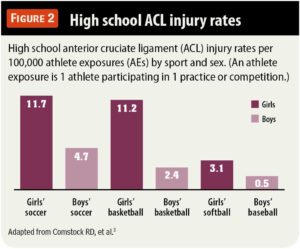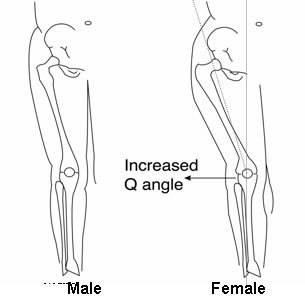Once rare in children, ACL injuries in kids have increased at the rate of 2.3% per year for more than 20 years. And the problem is even worse in girls, who are as much as 10 times more likely to suffer a tear or complete rupture of this critical knee ligament.
Consider the likelihood of a girl suffering an ACL injury versus a boy in the following sports:
- Basketball – For every injury to a male athlete, there are 3.5 injuries to a female athlete
- Volleyball – For every injury to a male athlete, there are 3 injuries to a female athlete
- Soccer – For every injury to a male athlete, there are 4 injuries to a female athlete
- Skiing – For every injury to a male athlete, there are 6 injuries to a female athlete
These numbers are problematic not only because of the gravity of the injuries themselves, but also because they make subsequent injuries more likely and over time can lead to longer-term problems, including early onset of arthritis in the injured knee.

Theories for the huge disparity between boys and girls vary, but a handful of key culprits are suspected, including biological differences in girls, kids’ growing habit of specializing in one sport, and an increasingly intense competitive environment in youth sports.
Fortunately, there are steps girls can take to reduce their likelihood of an ACL injury, and we’ll get to those in a minute. But first let’s look at why girls suffer higher rates of ACL tears.
Q ANGLE IN GIRLS
To assist in childbirth, females are born with a wider pelvis which, in the parlance of sports medicine, means girls have a larger Q angle (calculated by two intersecting lines using key points of the pelvis, spine and legs). In a nutshell, a girl’s Q angle averages 17 degrees while the average boy’s is 14 degrees.

That 3-degree difference in the Q angle has been linked to a variety of injuries and issues, including:
- ACL tears – Makes the knee less stable, thereby putting it under more stress.
- Patellofemoral Pain Syndrome – Known more commonly as ‘runner’s knee,’ the quadriceps muscle exerts a disproportionate pull on the patella (kneecap), leading to chronic pain.
- Chondromalacia – Also part of runner’s knee, this occurs when cartilage beneath the patella (kneecap) is worn down, leading to chronic pain.
MENSTRUAL CYCLES & HORMONES
Although it’s unclear precisely how or why hormones play a difference, researchers have found a connection between girls’ menstrual cycles and an increased likelihood of ACL injuries, particularly in that brief stretch of time each month before ovulation.
One study found a kind of double-whammy hurting girls: first, that higher levels of testosterone found in boys protect the knee against stresses; and estrogen reduces ACL strength. “Our thought was that while estrogen may make the female ACL weaker and more prone to injury, the male hormone testosterone may act to strengthen the ACL and protect it from injury,” said William Romani, a sports medicine researcher and visiting faculty member at Johns Hopkins University when the study took place.
Specifically, the research found that castrated rats suffered from weaker ACLs due to the absence of testosterone. Researchers also found testosterone receptors in the knees of both boys and girls.
FEMALE MECHANICS
Girls’ knees are more flexible than those of boys, which places more pressure on surrounding muscles, tendons, and ligaments to provide support. Alas, the muscle groups surrounding the ACL – in particular, those found in the hips, buttocks, and upper legs – are weaker in girls than boys.
While estrogen may make the female ACL weaker and more prone to injury, the male hormone testosterone may act to strengthen the ACL and protect it from injury.
The result is that while boys’ musculature and abundance of testosterone help to protect their knees in high-impact, lateral-movement sports like soccer, basketball, lacrosse, etc., girls’ knees are under far greater pressure (and, by extension, are more likely to suffer injuries). Some statistics, for example, show girl soccer players are eight times more likely to suffer ACL injuries.
Those same biomechanical differences in girls lead to differences in the ways they pivot, jump, and land – the very same actions that most often lead to ACL injuries.
When a girl lands from a jump, for example, she tends to land not only with the knee straight (boys tend to land with the knee bent), but also a bit knock-kneed, with the knees bent inward. The result, again, is increased pressure on the ACL.
OTHER STRESSORS
Girls’ ACLs also are under stress from youth sports’ growing obsession with specialization – i.e. kids playing one sport year-round (this is a culprit in the increase in boys’ injuries as well). Where, a generation ago, kids would participate in multiple sports across the year and develop different muscle groups, today kids are being pressured to play just one sport and, as a result, are overtaxing the same muscles and leading to injuries.
Kids today also are lifting weights and training at younger and younger ages even as the competitive pressures in youth sports intensifies. The result is kids playing at a greater level of intensity than a generation ago, leading to a propensity for more injuries.
PREVENTING ACL INJURIES IN GIRLS
Despite this seeming perfect storm of traits leading to increased ACL tears in girls, there are ways to reduce their likelihood of such injuries. An AAP study maintains that “Neuromuscular training appears to reduce the risk of injury in adolescent female athletes by 72%.”
Specifically, the AAP recommends “training that incorporates plyometric and strengthening exercises, combined with feedback to athletes on proper technique.”
The video below, featuring U.S. Women’s Soccer star, Ali Krieger, demonstrates 7 exercises girls can do to reduce their chances of suffering an ACL injury.
